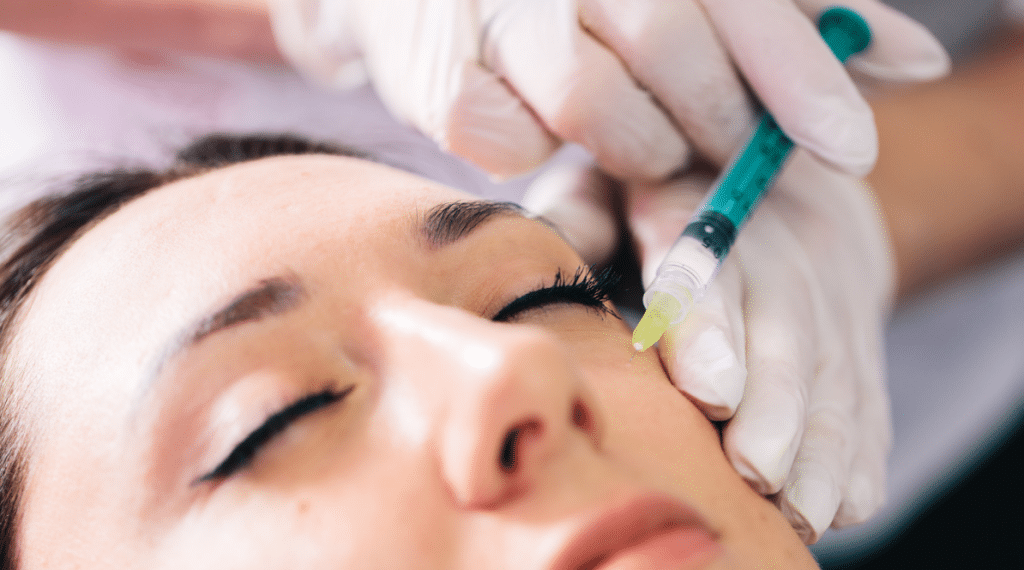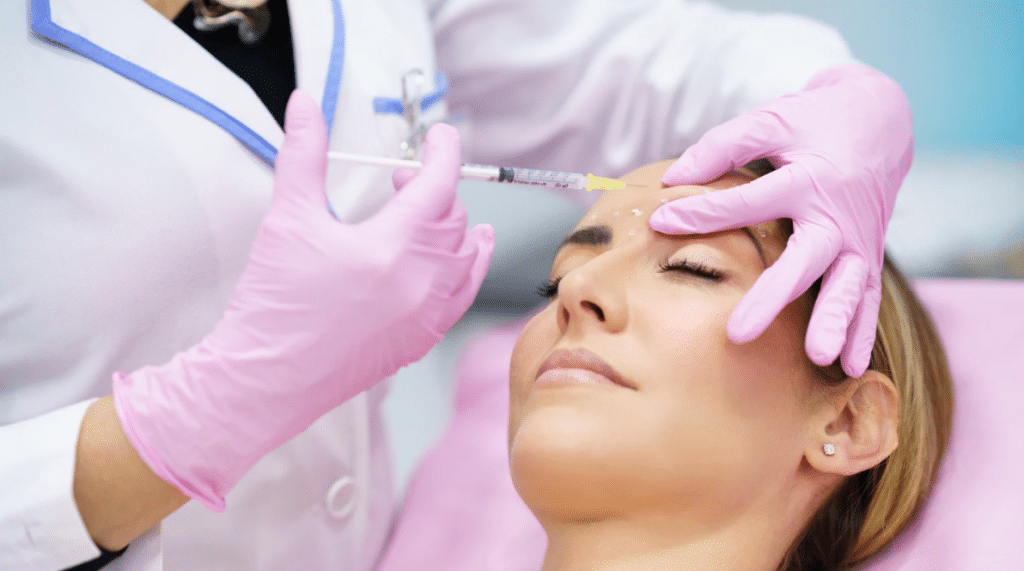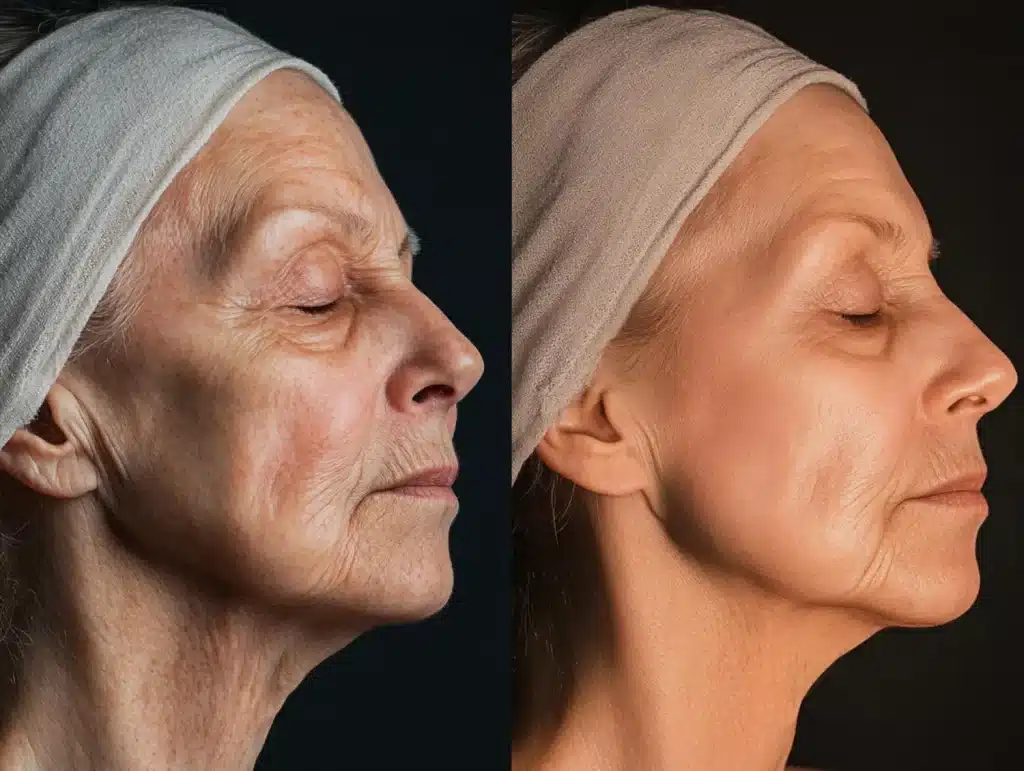According to Grand View Research, the market for botulinum toxin was valued at $5.9 billion in 2021 and is expected to grow at 6.9% through 2030. This growth shows how popular injectable treatments like Xeomin and Botox have become for reducing wrinkles. While similar, these products have unique features that interest users and doctors.
Understanding the differences between Xeomin and Botox is crucial for anyone considering these treatments. Both products effectively smooth wrinkles but are formulated differently and may work better for different skin types and preferences.
This has led to various patient options and a need for clear, straightforward information to help patients choose between them. This article will explore these distinctions in-depth, offering insights into which product might suit specific needs and preferences.
Key Takeaways
- Botulinum toxin treatments, including Xeomin and Botox, are popular for reducing wrinkles. The market for these treatments is expected to grow significantly through 2030.
- Xeomin is a “naked” botulinum toxin product, lacking complexing proteins found in Botox, which might reduce the risk of antibody development.
- Both products are effective in cosmetic and medical applications. However, patient preferences can vary based on the onset of action, duration of effects, and individual experiences.
- Cost varies by location and required units, with Xeomin treatments ranging from $8 to $18 per unit in the U.S.
- Insurance coverage for Xeomin is typically limited to medically necessary treatments, with some support programs available for eligible patients.
Overview of Botulinum Toxin Products

What is Botulinum Toxin?
Botulinum toxin is a potent neurotoxin produced by Clostridium botulinum and related species. It blocks the release of acetylcholine at the neuromuscular junction, leading to flaccid paralysis, a mechanism exploited in medical and cosmetic applications. Addressing what Xeomin is made of, seamlessly integrating into this context, it’s a formulation specifically of botulinum toxin type A, distinguished by its absence of complexing proteins, making it a “naked” form of the toxin. There are seven main types of botulinum toxin, types A to G, with types A and B most commonly used in humans for medical and cosmetic purposes due to their ability to cause disease and their effectiveness in treatment.
Common Uses in Medicine and Aesthetics
Botulinum toxin has many medical applications, including treating muscle spasticity in conditions like cerebral palsy, post-stroke spasticity, and overactive muscle movements in various body parts, including the eyelids, jaw, and limbs. It also treats chronic migraines, excessive sweating, and misaligned eyes (strabismus).
The Science Behind Xeomin and Botox

Composition and Purity
Both Xeomin (incobotulinumtoxinA) and Botox (onabotulinumtoxinA) are formulations of botulinum toxin type A. However, they differ in their composition and purity. Xeomin is a “naked” molecule, meaning it lacks the complex proteins present in Botox.
This absence of complex proteins in Xeomin might lead to a lower risk of developing antibodies against the toxin, potentially offering a purer formulation that can reduce sensitization and antibody formation.
Mechanism of Action
The mechanism of action for both Xeomin and Botox involves inhibiting acetylcholine release at the neuromuscular junction, which leads to temporary paralysis of the targeted muscles. This action is crucial for its efficacy in treating muscle-related disorders and aesthetic applications for reducing wrinkles.
Xeomin and Botox target the SNAP-25 protein, an essential component for synaptic vesicle transmission, thereby inhibiting muscle contractions. Differences in their diffusion characteristics and how they interact with muscle tissues can lead to variations in clinical outcomes. However, both have been proven effective for therapeutic and cosmetic uses.
Efficacy and Performance
Onset of Action
Xeomin and Botox have different timelines for the visibility of their effects post-treatment. Xeomin’s results can be seen within three to five days after injection, offering a quicker onset of action than Botox, which typically shows results around two weeks after treatment. This faster result time with Xeomin might be preferable for those seeking quicker visible outcomes.
Duration of Effect
Another area where Xeomin and Botox differ is the duration of effect. Xeomin has been noted for its longer-lasting results, potentially extending up to six months, compared to Botox, which typically lasts about three to four months. This longer duration might reduce the need for frequent maintenance treatments, appealing to those looking for a longer-term solution.
Treatment Areas and Applications
Aesthetic Treatments
Xeomin and Botox are FDA-approved for cosmetic applications, such as minimizing the appearance of fine lines and wrinkles. They effectively treat areas like wrinkles between the eyebrows, fine lines on the cheeks, and forehead wrinkles caused by repetitive muscle contractions from facial expressions.
The choice between Xeomin and Botox for aesthetic purposes can largely depend on individual preferences, as both offer effective solutions for improving the appearance of fine lines and wrinkles.
Medical Treatments
In addition to their cosmetic uses, both Xeomin and Botox have medical applications, treating conditions such as cervical dystonia, neck spasms, eye twitching, and arm spasms. Their use extends beyond aesthetic improvements, offering significant benefits in managing various medical conditions involving muscle spasms and involuntary movements.
Side Effects and Safety Profile
Common Side Effects
Like all botulinum toxin products, Xeomin can cause some side effects, though most are usually mild and temporary. Commonly reported side effects include injection site reactions like bruising, swelling, soreness, and occasionally short-term headaches.
Other frequent effects include stuffy or runny nose and unusual tiredness or weakness. Blepharospasm, blurred vision, diarrhea, drooping upper eyelids, and dry mouth have been notedfor specific treatments.
Rare Complications
While rare, Xeomin can lead to more serious complications. One of the serious conditions includes the spread of toxin effects, potentially causing symptoms akin to botulism, such as muscle weakness, difficulty swallowing, or breathing problems, which can appear hours to weeks after injection.
Additionally, swallowing problems severe enough to require a feeding tube, loss of bladder control, and allergic reactions, including anaphylaxis, have been reported but are very uncommon.
Patient Experiences and Satisfaction
Comparative Studies
Comparative studies of Xeomin and Botox have not shown significant differences in effectiveness and overall patient satisfaction for cosmetic purposes. Both have been proven effective in treating wrinkles and fine lines and have similar safety profiles. However, individual responses can vary, influencing patient preference for one over the other.
Patient Preferences and Feedback
Many patients choose Xeomin over Botox due to its “naked” formulation, which lacks complex proteins, potentially reducing the risk of developing resistance or having allergic reactions. Xeomin’s quicker onset of results, visible within three to five days, and its longer-lasting effect, up to six months, are often cited by patients as reasons for preference.
However, the choice between Xeomin and Botox can ultimately depend on personal experiences, expected outcomes, and individual body responses. Some patients may prefer Botox due to its longer history and broader name recognition.
Cost and Accessibility
Pricing Models
The cost of Xeomin treatments varies widely depending on the number of units required, the treatment area, the provider’s experience, and the geographic location. Generally, the cost per unit of Xeomin ranges from $8 to $18 in the U.S., with average treatment areas requiring specific units.
For instance, forehead lines might need 15 to 25 units, while glabellar lines could require 20 to 30. Overall, the total cost can significantly differ from state to state, with higher prices along the U.S. coasts.
Internationally, Xeomin costs can also vary, offering potentially lower prices in countries outside the United States. Prices can range from $25 in Colombia to $1,000 in Canada and Australia, considering additional expenses such as travel and provider reputation that should also be considered when considering getting the procedure done abroad.
Insurance Coverage and Availability
Typically, cosmetic procedures like Xeomin are not covered by insurance as they are considered elective. However, Xeomin treatments that provide medical benefits for documented conditions may sometimes be covered. It’s crucial to consult with your insurance provider to understand the coverage details for medically necessary treatments.
There are patient support programs available for patients receiving Xeomin for therapeutic purposes, such as treating upper limb spasticity, cervical dystonia, or chronic sialorrhea. These programs may offer financial assistance or reimbursement for out-of-pocket medication costs and related administration fees not covered by insurance, subject to eligibility criteria and insurance coverage policies.
Conclusion
Xeomin and Botox offer valuable options for those seeking botulinum toxin treatments for cosmetic or medical reasons. Understanding their differences in composition, effectiveness, patient satisfaction, side effects, and cost is crucial for making informed decisions.
While both have proven efficacy, individual preferences, treatment areas, and specific needs play significant roles in choosing between them. Consulting with healthcare providers is essential for tailoring treatments to patients’ unique circumstances.
About: Medical Spa RX is the trusted provider for medical practices looking to stock up on premium products, including the guide on “how to order Xeomin” through our platform. We offer safe and rigorously tested options like Ellanse filler, ensuring top quality for your practice. Our purchasing process is simple and straightforward, making it easy to acquire popular and reliable products like Profhilo swiftly. Additionally, we provide special discounts, wholesale rates, and free shipping for bulk purchases, enabling your practice to maintain an excellent stock and continuously offer a broad range of available treatments.
FAQs
- What are the main differences between Xeomin and Botox?
Xeomin is a “naked” botulinum toxin without complexing proteins present in Botox, potentially reducing the risk of developing antibodies and offering a purer formulation.
- How long does Xeomin take to show results, and how long do they last?
Xeomin’s effects can be seen within three to five days after treatment, with results potentially lasting up to six months, longer than the typical three to four months observed with Botox.
- Are there any common side effects associated with Xeomin?
Yes, common side effects include injection site reactions such as bruising, swelling, soreness, and occasional headaches, similar to those observed with other botulinum toxin treatments.
- Can insurance cover Xeomin’s treatments?
While cosmetic procedures are generally not covered, Xeomin treatments for certain medical conditions may be eligible for insurance coverage. It’s essential to consult with insurance providers for specifics.
- How much does Xeomin cost?
The cost of Xeomin treatments varies, averaging $8 to $18 per unit in the U.S., with total costs depending on the treatment area, provider, and geographic location.
References
Global Market Insights. (n.d.). Botulinum toxin market size. Retrieved from https://www.gminsights.com/industry-analysis/botulinum-toxin-market
Skin Therapy Letter. (n.d.). Botulinum toxin: An overview. Retrieved from https://www.skintherapyletter.com/aging-skin/botulinum-toxin-overview/
Cleveland Clinic. (n.d.). Xeomin vs. Botox: What to know about both. Retrieved from https://health.clevelandclinic.org/xeomin-vs-botox
Drugs.com. (n.d.). Xeomin side effects. Retrieved from https://www.drugs.com/sfx/xeomin-side-effects.html
AEDIT. (n.d.). How much does Xeomin® cost? (See prices near you). Retrieved from https://aedit.com/procedure/xeomin/cost
XEOMIN®. (n.d.). Patient support program. Retrieved from https://www.xeomin.com/patient-assistance XEOMIN®. (n.d.). FAQ. Retrieved from https://www.xeomin.com/faq





















